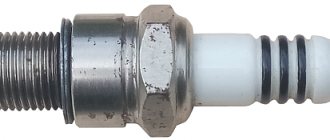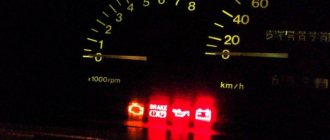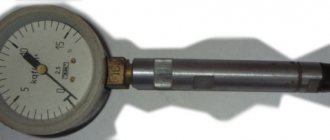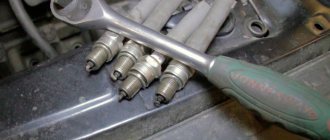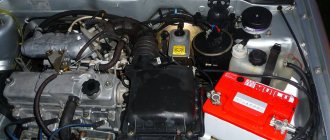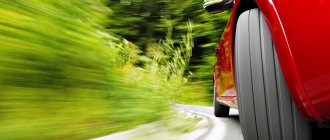>If the VAZ 2109 jerks when moving, then the reason lies in one of the following malfunctions: 1) Problems in the VAZ 2109 power system.
Power system VAZ 2109
2) Problems in the ignition system of the VAZ 2109.
Ignition system VAZ 2109
Dirty fuel filter VAZ 2109
2) Mesh filter in . A clogged filter leads to the same thing - the VAZ 2109 carburetor does not receive the required amount of fuel. It is necessary to check the cleanliness of the filter and, if necessary, blow it with compressed air. 3) VAZ 2109 carburetor accelerator pump. If the car jerks during acceleration, this very often indicates a malfunction of the VAZ 2109 accelerator pump. 4) Sediment in the carburetor float chamber. If the VAZ 2109 jerks not during acceleration, but precisely when the car is moving evenly with the gas pedal in a fixed position, then this may be caused by debris getting from the float chamber into the fuel nozzles. To check, remove the carburetor cover and make sure that the float chamber does not contain sediment. 5) Fuel pump VAZ 2109. If the car jerks at high speeds, then perhaps the fuel pump does not provide the necessary fuel supply. To increase the fuel supply, adjust the fuel pump pusher.
Adjusting the fuel supply in the fuel pump VAZ 2109
6) Poor quality of gasoline. It happens that you can refuel with gasoline mixed with water. Naturally, water does not burn, and when it gets into the engine it causes the engine to jerk. 7) Low fuel level in the tank. Due to the fact that fuel is mixed with air, the car may jerk. Here, in principle, are all the main reasons for the fuel system. In principle, everything is clear: first, we check the carburetor to ensure it is not clogged and the fuel supply. If everything is in order, then the ignition system of the VAZ 2109 comes under suspicion. Malfunctions of the ignition system of the VAZ 2109, causing the car to jerk. 1) Vacuum corrector of the ignition distributor of the VAZ 2109. We check the tightness of the tube from the carburetor to the vacuum corrector, as well as the ease of movement of the correcting shutters.
Ignition distributor VAZ 2109
2) Burning of the ignition distributor contacts. 3) Test for ground or spark plugs. If the engine operates properly at idle, this does not mean that it will behave this way in all engine operating modes. Under load, due to poor insulation, a spark plug or high-voltage wire can be pierced to ground, but work normally at idle.
High-voltage wires VAZ 2109
4). The switch may also behave inappropriately. It may work fine, and then, within a couple of minutes, misfire. Personally, I always carry a spare switch with me. I know that many people do the same. Therefore, if possible, install a spare switch and ride it. If the problem goes away, then the problem was in the old switch.
Switch VAZ 2109
5) When the ignition coil overheats, it can also be the cause of jerking in the VAZ 2109. As you can see, there are many reasons, and it is not always immediately clear where to go. But if you check all the points listed above one by one, then the reason that the VAZ 2109 is twitching will be discovered.
Causes of malfunction
Troubleshooting is an incorrect air-fuel mixture ratio in the combustion chamber or a lack of spark. In this case, the crankshaft may turn with difficulty, or there will be misfires.
Many car enthusiasts started with carburetor engines and therefore know perfectly well why the engine misfires, but not everyone can fix the problem because they don’t know what the problem is. It is worth understanding that the tripping effect occurs due to a disruption in the supply of one of the elements - air, fuel and spark. It is in the systems that are responsible for these elements that we should look for the cause.
So, let's look at the components where you should look for the reason why the VAZ 2109 engine with a carburetor injection system is tripping:
- Carburetor.
- Fuel.
- Fuel pump and filter.
- Spark.
- Air filter.
What causes the car to jerk when running at low speeds?
Since the car begins to twitch when reaching even low speeds, it will not be possible to immediately identify one specific problem. Problems may be hidden:
- In the engine fuel mixture supply system;
- In the vehicle ignition system;
- At the checkpoint;
- In the distributor design;
- Includes fuel filters;
- In the sparking system;
- In the control unit of the vehicle's on-board computer.
Let's go through the faults in each of the listed systems in detail.
Tip: When detecting a “jerking” behavior in the vehicle, the brakes may also squeak when braking. These 2 problems can be either interrelated or indicate completely different breakdowns.
Checking the engine fuel mixture supply system
Often the reason that the car jerks at low speeds is due to a malfunction of the power system. When the car starts to move, the cylinders simply cannot receive the required amount of fuel mixture, as a result of which the car is unable to transfer the required amount of power to the chassis for smooth driving and smooth commissioning of the transmission. As a result of increased pressure and transmission resistance, uneven running of the machine appears.
To solve this problem, it is recommended that you first pay attention to checking the throttle body. It also wouldn’t hurt to test and diagnose the performance of the sensors installed in the system for determining idle speed indicators. Do not forget to check the serviceability of the throttle valve position and the mass air flow sensor.
Throttle body
During diagnostics, most often a breakdown is found in the injectors responsible for uniform injection of the fuel mixture. In rare cases, engine jerking problems may be related to the air ducts that connect the injector receiver to the air filter structure. Here the problem lies in depressurization of connections and loss of pressure.
The solution to the problem is to replace all faulty components yourself or with the help of car service specialists. After repair, it is recommended to ensure that all connections are in good working order and that there is no loss of pressure in the fuel line system that is connected to the fuel pump itself.
Elimination methods
It is worth understanding that tripling on a carburetor power unit will occur not only while driving, but also at idle speed. In this case, the motor will make sounds like popping noises. But the car will twitch only while driving. So, it’s worth going directly to the analysis of the process of diagnosing and troubleshooting.
Carburetor
Unlike injection engines, a carburetor is a rather finicky thing that is sensitive to fuel and the technical condition of parts. Therefore, many motorists know that the power unit can stall precisely because of the carburetor. This version of the car was equipped with an injection element marked Solex, with which many are familiar.
To cure the shaking and jerking of the car, you will have to sort out and clean the carburetor. The cleaning process occurs manually or using a special oven that heats the cleaning liquid. But, as practice shows, most car enthusiasts who clean carbs with their own hands do the process completely manually.
Calibration data for the carburetor installed on VAZ 2108, VAZ 2109, VAZ 21099 vehicles
After the carburetor has been rebuilt, it needs to be adjusted. Adjustment is carried out using quality and quantity screws until the optimal ratio of fuel supplied to the chamber for forming the air-fuel mixture is achieved.
Fuel
If for an injection engine the poor quality of fuel is even more or less tolerable and you can drive, then for a carburetor engine it is a disaster. Bad fuel not only clogs the jets, but also quickly damages the fuel pump.
Poor quality gasoline can be identified immediately, since the engine begins to “chug”, traction disappears, and if you open the float chamber of the carburetor, the liquid called gasoline will be sticky and will not pass through the nozzles well.
To eliminate the problem, you will have to disassemble and clean the entire fuel system, including the removal of the fuel tank. After cleaning, you need to fill in, albeit expensive, but high-quality gasoline and drive 50-60 kilometers to clean the valve mechanism and piston group.
Although this may no longer help, since the valves and pistons are burned out, and this is precisely the reason. Then a major overhaul of the engine will be required.
Fuel pump and filter
Another reason that the engine starts to stall is an insufficient or intermittent supply of fuel to the carburetor. In this case, the problem will lie precisely in the fuel pump or a dirty filter element.
Therefore, it is recommended to check these elements for functionality. If necessary, repair the fuel pump and replace the fuel filter.
Spark
A missing spark is a sign of a malfunction of the ignition system. Namely, spark plugs, wires or a coil could have failed. Spark plugs are checked on a special spark plug stand, but if there is none, then it is necessary to inspect the elements for damage, measure gaps and resistance. If a malfunction is detected, replace damaged parts.
During the diagnostic process, high-voltage wires are measured for resistance and also inspected for damaged insulation. If you find that one or more wires are broken, they should be replaced. The new wire should have a resistance of 5 ohms.
This is interesting: Wiring diagram for VAZ 2107 carburetor
Air filter
Communities › VAZ: Repair and Improvement › Blog › She drove and drove and suddenly began to twitch. 2109 carb.
Friends, please help me with advice. My car was driving normally, I would even say good, and suddenly, when starting from a traffic light, it began to twitch. Somehow I switched to the second one. I press the gas smoothly and the twitching stops. As soon as you press the pedal to the middle, it twitches again. And so on in all gears. It holds smooth at idle. 900. I accelerate on the spot, the revolutions do not float or fall. It jerks only when accelerating, if you press the pedal to a third. And also, if when driving, for example, at a speed of 40 - 60 km. h. I sharply press the pedal to the floor, it starts to choke and shoot in my carburetor. What the hell is this? I myself blame the accelerator pump or the vacuum chamber on the distributor. What do you think? Thanks in advance.
FakeHeader
Comments 39
There was a problem of the same kind. It turned out there was a bad contact on the plug that goes to the hall sensor, or rather the minus was bad.
In short, I discovered the cause and eliminated it. There was a bad contact on the connector of the HOL switch (which is on the distributor). During sharp acceleration, the engine leaned back and the contact lost power. Thanks to all.
I was happy early. Traveled 10 km. and twitched. I repeated the procedure with suction (up to 5 tons of volume) and drove off again. 15 km. the flight is normal. These are the miracles.
I'll report back briefly. I remembered that the carb has a fine filter, so I decided to take a look. He unscrewed it, pulled out the mesh and blew it out. Although she was already clean. I decided to tug on the explosive wires and accidentally touched the wire of the coolant temperature sensor. The engine jerked. The wire began to move, the engine began to twitch. Disconnected the motor wire. stalled. Pressed the contacts on the terminal and inserted it into place. I started the engine, warmed it up and pulled the choke sharply several times. Raising the speed to 3x.-4x. thousand...And she GO! I don’t know what happened. I drove around the area for about 10 minutes, it goes as before. Some kind of miracles. Thank you all for your kind words and participation!
accelerator pump / hall sensor / switch / capacitor in the distributor / perhaps one spark plug is cut out. It's easy to check the fuel pump; you rip out the hose from the carb and start the car.
you think correctly, the accelerator is most likely clogged
I was also twitching, I changed the fuel pump with the rod and cleaned the carb with all the jets. The problem is gone.
Now I have carried out “diagnostics”, the pump pumps normally, the accelerator splashes where it should, it accelerates well in place and does not stall. But he doesn’t want to go. And only FORWARD, engaged the rear, starts with slipping, and jerks forward. That's funny! Now I’ll go with the choke and try to get going.
remove the carb and blow it out and check the membrane at the same time
Yes, judging by the quality of the gasoline + all sorts of other crap accumulates in the tank over time, something clearly gets into the carb and it’s clogged. remove, rinse, blow, change membranes if bad
if it jerks during acceleration, you need to start with the fuel system, change the filter, flush the carburetor, the problem I think is that at the time of acceleration there is not enough fuel in the chamber, this is purely my opinion)
If your engine runs smoothly with smooth throttle release, then what does the ignition have to do with it? obvious lack of fuel. look from the pump to the carb. Most likely just clean the carb and everything will be fine.
Mmm. and the carb did not unwind? I had something like this right after the purchase, it was unexpected
Look at the fuel pump rod!
The advice is to remove it, wash it and rehearse the carb and forget about it.
I think it’s something to do with the carb; on my 9th, in three years, I had these symptoms twice! and all carbs! and during jerks the suction did not try to tighten! I passed!
On the O6 the accelerator was soaring and the brain was simply infuriating during aggressive driving.
In any case, the vacuum seal disappears, half of the people drive without it, most likely it really is the accelerator
which half? You and your loved ones?
